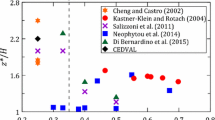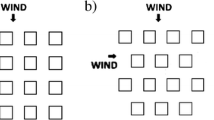Abstract
Wind speed is reduced above urban areas due to their high aerodynamic roughness. This not only holds for above the urban canopy. The local vertical wind profile is modified. Aerodynamic roughness (both roughness length and displacement height) therefore is relevant for many fields within human biometeorology, e.g. for the identification of ventilation paths, the concentration and dispersion of air pollutants at street level or to simulate wind speed and direction in urban environments and everything depending on them. Roughness, thus, also shows strong influence on human thermal comfort. Currently, roughness parameters are mostly estimated using classifications. However, such classifications only provide limited assessment of roughness in urban areas. In order to calculate spatially resolved roughness on the micro-scale, three different approaches were implemented in the SkyHelios model. For all of them, the urban area is divided into reference areas for each of the obstacles using a voronoi diagram. The three approaches are based on building and [+one of them also on] vegetation (trees and forests) data. They were compared for the city of Stuttgart, Germany. Results show that the approach after Bottema and Mestayer (J Wind Eng Ind Aerodyn 74–76:163–173 1998) on the spatial basis of a voronoi diagram provides the most plausible results.






Similar content being viewed by others
References
Bottema M (1997) Urban roughness modelling in relation to pollutant dispersion. Atmos Environ 31 (18):3059–3075. doi:10.1016/S1352-2310(97)00117-9
Bottema M, Mestayer PG (1998) Urban roughness mapping—validation techniques and some first results. J Wind Eng Ind Aerodyn 74–76:163–173. doi:10.1016/S0167-6105(98)00014-2
Bröde P, Fiala D, Blazejczyk K, Holmér I, Jendritzky G, Kampmann B, Tinz B, Havenith G (2012) Deriving the operational procedure for the universal thermal climate index (UTCI). Int J Biometeorol 56 (3):481–494. doi:10.1007/s00484-011-0454-1
Brutsaert W (1975) Comments on surface roughness parameters and the height of dense vegetation. J Meteorol Soc Japan 53:96–97
Charalampopoulos I, Tsiros I, Chronopoulou-Sereli A, Matzarakis A (2013) Analysis of thermal bioclimate in various urban configurations in Athens, Greece. Urban Ecosyst 16:217–233. doi:10.1007/s11252-012-0252-5
Charalampopoulos I, Tsiros I, Chronopoulou-Sereli A, Matzarakis A (2015) A note on the evolution of the daily pattern of thermal comfort-related micrometeorological parameters in small urban sites in Athens. Int J Biometeorol 59:1223–1236. doi:10.1007/s00484-014-0934-1
Compagnon R, Raydan D (2000) Irradiance and llumination Distributions in Urban Areas Proceedings of the 17th International Conference on Passive and Low Energy Architecture (PLEA) Cambridge, UK
Counihan J (1975) Adiabatic atmospheric boundary layers: a review and analysis of data from the period 1880–1972. Atmos Environ (1967) 9 (10):871–905. doi:10.1016/0004-6981(75)90088-8, http://www.sciencedirect.com/science/article/pii/0004698175900888
Davenport AG, Grimmond CSB, Oke TR, Wieringa J (2000) Estimating the roughness of cities and sheltered country. In: 15Th Conference on Probability and Statistics in the Atmospheric Sciences/12th Conference on Applied Climatology, Ashville, NC, American Meteorological Society, pp 96–99
Fanger PO, Toftum J (2002) Extension of the PMV model to non-air-conditioned buildings in warm climates: special issue on thermal comfort standards. Energy Build 34(6):533–536. doi:10.1016/S0378-7788(02)00003-8, http://www.sciencedirect.com/science/article/pii/S0378778802000038
Fortune S (1987) A sweepline algorithm for Voronoi diagrams. Algorithmica 2(1-4):153–174. doi:10.1007/BF01840357
Fröhlich D, Matzarakis A (2013) Modeling of changes in thermal bioclimate: examples based on urban spaces in Freiburg, Germany. Theor Appl Climatol 111:547–558. doi:10.1007/s00704-012-0678-y 10.1007/s00704-012-0678-y
Gagge AP, Fobelets A, Berglund L (1986) A standard predictive index of human response to the thermal environment. ASHRAE Transactions (92, Pt 1):709–731
Gál T, Unger J (2009) Detection of ventilation paths using high-resolution roughness parameter mapping in a large urban area. Build Environ 44(1):198–206. doi:10.1016/j.buildenv.2008.02.008 10.1016/j.buildenv.2008.02.008
Gál T, Lindberg F, Unger J (2009) Computing continuous sky view factors using 3D urban raster and vector databases: comparison and application to urban climate. Theor Appl Climatol 95(1-2):111–123. doi:10.1007/s00704-007-0362-9
Grimmond CSB, Oke TR (1999) Aerodynamic properties of urban areas derived from analysis of surface form. J Appl Meteorol 38(9):1262–1292. doi:10.1175/1520-0450(1999)038%3C1262:APOUAD%3E2.0.CO;2
Grimmond CSB, King TS, Roth M, Oke TR (1998) Aerodynamic roughness of urban areas derived from wind observations. Bound.-Layer Meteorol 89(1):1–24. doi:10.1023/A:1001525622213 10.1023/A:1001525622213
Havenith G, Fiala D, Blazejczyk K, Richards M, Bröde P, Holmér I, Rintamaki H, Benshabat Y, Jendritzky G (2012) The UTCI-clothing model. Int J Biometeorol 56(3):461–470. doi:10.1007/s00484-011-0451-4
Höppe P (1999) The physiological equivalent temperature—a universal index for the biometeorological assessment of the thermal environment. Int J Biometeorol 43(2):71–75. doi:10.1007/s004840050118
Jendritzky G, de Dear R, Havenith G (2012) UTCI—why another thermal index? Int J Biometeorol (56):421–428
Johansson E, Emmanuel R (2006) The influence of urban design on outdoor thermal comfort in the hot, humid city of Colombo, Sri Lanka. Int J Biometeorol 51(2):119–133. doi:10.1007/s00484-006-0047-6
Ketterer C, Matzarakis A (2014a) Comparison of different methods for the assessment of the urban heat island in Stuttgart, Germany. International Journal of Biometeorology. doi:10.1007/s00484-014-0940-3
Ketterer C, Matzarakis A (2014b) Human-biometeorological assessment of heat stress reduction by replanning measures in Stuttgart, Germany. Landsc Urban Plan 122:78–88. doi:10.1016/j.landurbplan.2013.11.003
Kondo J, Yamazawa H (1986) Aerodynamic roughness over an inhomogenous ground surface. Bound.-Layer Meteorol 35(4):331–348. doi:10.1007/BF00118563, wOS:A1986C503200003
Landsberg HE (1981) The urban climate. The Academic Press, London
Lettau H (1969) Note on aerodynamic roughness—parameter estimation on the basis of roughness-element description. J Appl Meteorol 8 (5):828–832. doi:10.1175/1520-0450(1969)008%3C0828:NOARPE%3E2.0.CO;2
Lin TP, Matzarakis A (2008) Tourism climate and thermal comfort in Sun Moon Lake, Taiwan. Int J Biometeorol 52(4):281–290. doi:10.1007/s00484-007-0122-7
Macdonald RW (2000) Modelling the mean velocity profile in the urban canopy layer. Bound.-Layer Meteorol 97(1):25–45. doi:10.1023/A:1002785830512, wOS:000088631900002
Macdonald RW, Griffiths RF, Hall DJ (1998) An improved method for the estimation of surface roughness of obstacle arrays. Atmos Environ 32(11):1857–1864. doi:10.1016/S1352-2310(97)00403-2 10.1016/S1352-2310(97)00403-2
Matzarakis A, Matuschek O (2011) Sky view factor as a parameter in applied climatology—rapid estimation by the SkyHelios model. Meteorol Z 20(1):39–45. doi:10.1127/0941-2948/2011/0499
Matzarakis A, Mayer H (1992) Mapping of urban air paths for planning in Munich. In: Planning applications of urban and building climatology Wissenschaftliche Berichte des Instituts für Meteorologie und Klimaforschung Universität Karlsruhe 16
Matzarakis A, Mayer H, Iziomon MG (1999) Applications of a universal thermal index: physiological equivalent temperature. Int J Biometeorol 43(2):76–84. doi:10.1007/s004840050119
Matzarakis A, Rocco M, Najjar G (2009) Thermal bioclimate in Strasbourg—the 2003 heat wave . Theor Appl Climatol 98(3-4):209–220. doi:10.1007/s00704-009-0102-4
Mayer H, Höppe PR (1987) Thermal comfort of man in different urban environments. Theor Appl Climatol 38(1):43–49. doi:10.1007/BF00866252
Mayer H, Matzarakis A (1992) Stadtklimarelevante Luftströmungen im Münchner Stadtgebiet: Forschungsvorhaben STADTLUFT
MOGRE Community (2016) Managed open graphics rendering engine. http://www.ogre3d.org/tikiwiki/MOGRE
Open Source Geospatial Foundation (2016) GDAL: GDAL—Geospatial Data Abstraction Library. http://www.gdal.org/
Ottmann T, Widmayer P (2012) Algorithmen und Datenstrukturen. Springer, Berlin
Ratti C, Di Sabatino S, Britter R (2006) Urban texture analysis with image processing techniques: winds and dispersion. Theor Appl Climatol 84(1-3):77–90. doi:10.1007/s00704-005-0146-z
Stewart ID, Oke TR (2012) Local climate zones for urban temperature studies. Bull Am Meteorol Soc 93 (12):1879–1900. doi:10.1175/BAMS-D-11-00019.1
Wieringa J (1993) Representative roughness parameters for homogeneous terrain. Bound-Layer Meteorol 63 (4):323–363. doi:10.1007/BF00705357
Acknowledgments
This work is financially supported by the transnational cooperation project 3CE292P3 within the Central Europe Programme “Development and application of mitigation and adaptation strategies and measures for counteracting the global urban heat island phenomenon”. This project is implemented through the CENTRAL Europe Programme co-financed by the ERDF.
We thank the Office for Environmental Protection, section of urban climatology of Stuttgart, for providing climate data of Stuttgart Schwabenzentrum and Land Surveying Office, Stuttgart for the spatial data.
Dominik Fröhlich wants to acknowledge the support of the Heinrich-Böll foundation.
Author information
Authors and Affiliations
Corresponding author
Rights and permissions
About this article
Cite this article
Ketterer, C., Gangwisch, M., Fröhlich, D. et al. Comparison of selected approaches for urban roughness determination based on voronoi cells. Int J Biometeorol 61, 189–198 (2017). https://doi.org/10.1007/s00484-016-1203-2
Received:
Revised:
Accepted:
Published:
Issue Date:
DOI: https://doi.org/10.1007/s00484-016-1203-2




